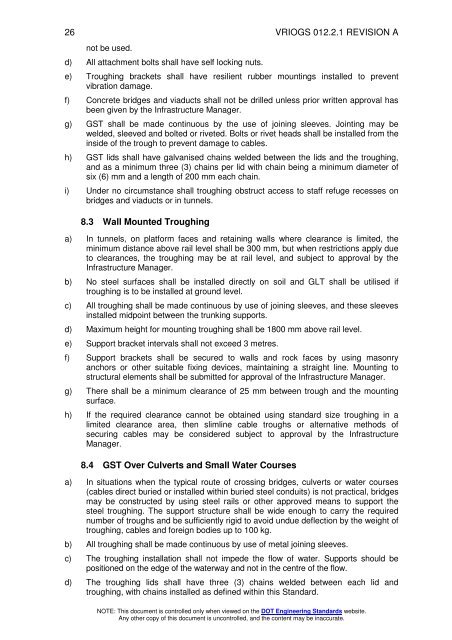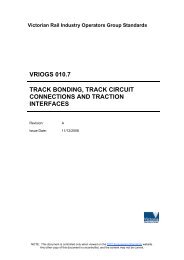VRIOGS 012.2.1 - Public Transport Victoria
VRIOGS 012.2.1 - Public Transport Victoria
VRIOGS 012.2.1 - Public Transport Victoria
Create successful ePaper yourself
Turn your PDF publications into a flip-book with our unique Google optimized e-Paper software.
26 <strong>VRIOGS</strong> <strong>012.2.1</strong> REVISION A<br />
not be used.<br />
d) All attachment bolts shall have self locking nuts.<br />
e) Troughing brackets shall have resilient rubber mountings installed to prevent<br />
vibration damage.<br />
f) Concrete bridges and viaducts shall not be drilled unless prior written approval has<br />
been given by the Infrastructure Manager.<br />
g) GST shall be made continuous by the use of joining sleeves. Jointing may be<br />
welded, sleeved and bolted or riveted. Bolts or rivet heads shall be installed from the<br />
inside of the trough to prevent damage to cables.<br />
h) GST lids shall have galvanised chains welded between the lids and the troughing,<br />
and as a minimum three (3) chains per lid with chain being a minimum diameter of<br />
six (6) mm and a length of 200 mm each chain.<br />
i) Under no circumstance shall troughing obstruct access to staff refuge recesses on<br />
bridges and viaducts or in tunnels.<br />
8.3 Wall Mounted Troughing<br />
a) In tunnels, on platform faces and retaining walls where clearance is limited, the<br />
minimum distance above rail level shall be 300 mm, but when restrictions apply due<br />
to clearances, the troughing may be at rail level, and subject to approval by the<br />
Infrastructure Manager.<br />
b) No steel surfaces shall be installed directly on soil and GLT shall be utilised if<br />
troughing is to be installed at ground level.<br />
c) All troughing shall be made continuous by use of joining sleeves, and these sleeves<br />
installed midpoint between the trunking supports.<br />
d) Maximum height for mounting troughing shall be 1800 mm above rail level.<br />
e) Support bracket intervals shall not exceed 3 metres.<br />
f) Support brackets shall be secured to walls and rock faces by using masonry<br />
anchors or other suitable fixing devices, maintaining a straight line. Mounting to<br />
structural elements shall be submitted for approval of the Infrastructure Manager.<br />
g) There shall be a minimum clearance of 25 mm between trough and the mounting<br />
surface.<br />
h) If the required clearance cannot be obtained using standard size troughing in a<br />
limited clearance area, then slimline cable troughs or alternative methods of<br />
securing cables may be considered subject to approval by the Infrastructure<br />
Manager.<br />
8.4 GST Over Culverts and Small Water Courses<br />
a) In situations when the typical route of crossing bridges, culverts or water courses<br />
(cables direct buried or installed within buried steel conduits) is not practical, bridges<br />
may be constructed by using steel rails or other approved means to support the<br />
steel troughing. The support structure shall be wide enough to carry the required<br />
number of troughs and be sufficiently rigid to avoid undue deflection by the weight of<br />
troughing, cables and foreign bodies up to 100 kg.<br />
b) All troughing shall be made continuous by use of metal joining sleeves.<br />
c) The troughing installation shall not impede the flow of water. Supports should be<br />
positioned on the edge of the waterway and not in the centre of the flow.<br />
d) The troughing lids shall have three (3) chains welded between each lid and<br />
troughing, with chains installed as defined within this Standard.<br />
NOTE: This document is controlled only when viewed on the DOT Engineering Standards website.<br />
Any other copy of this document is uncontrolled, and the content may be inaccurate.

















